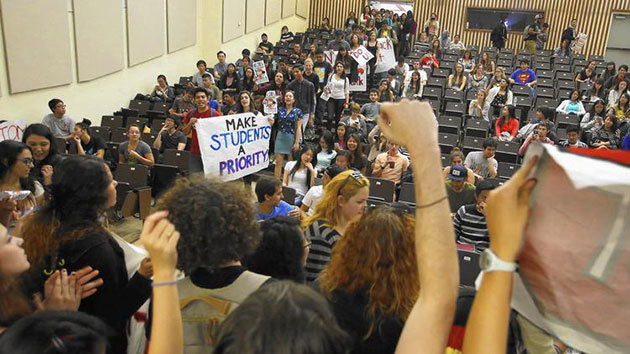Many want more money; UC should get in line

by George Skelton
First of all, Californians think that raising university tuition again is a really bad idea. A non-starter.
Second, although the University of California is crying for more state money, it needs to get in line. Join the crowd of folks with their hands out.
K-12 schools, the impoverished aged and disabled, highway users — among others — also are clamoring for more tax dollars. Many make compelling cases, having suffered from Sacramento’s budget cutting during the recession.
Lawmakers found higher ed relatively easy to whack. UC and Cal State could make up the loss by hiking tuition, which they did dramatically. And the university boards were cursed, not the politicians.
Actually, the universities began hitting up students long before the recession. Tuition at both systems are roughly eight times what they were 25 years ago — $12,192 annually at UC, $5,472 at Cal State. Plus there’s room, board, books and campus fees. Students graduate deep in hock, forced to spend their earnings paying off long-term loans rather than stimulating the economy.
Remember, this is a state that until a generation or two ago offered tuition-free college educations. In return, California obtained a skilled worker pool that repaid the state many times over with decades of consumer buying and tax payments. It set California apart.
Now, the UC regents — listening to new university President Janet Napolitano and ignoring popular Gov. Jerry Brown — have voted to hike tuition by 5% annually for five years unless Sacramento ponies up at least an additional $100 million each year. They’re holding students hostage for state ransom.
The Public Policy Institute of California asked people about this in a poll released last week and found record opposition to a tuition increase.
Those surveyed were asked: What if more money were needed just to maintain current funding levels for public universities? Would a tuition increase be OK? “No,” replied 77% of voters. Only 20% said “yes.”
“Tuition is something Democrats and Republicans can agree on,” says Mark Baldassare, the policy institute’s president and pollster. “People feel it’s important to have more college graduates and think affordability is a problem.”
Well then, how about paying higher taxes to help the universities? Voters were opposed to that too. No 58%, yes 40%.
Paradoxically, 54% of voters opined that current funding for public universities was insufficient.
Presumably, that means they think Sacramento should reprioritize state spending. But what gets trimmed?
K-12 schools, with their 6.2 million students, eat up by far the largest slice of the $108-billion general fund: nearly 42%. The second biggest chunk, 27.5%, is for health and human services. Higher education —including community colleges — is third at 11.6%. (UC and Cal State each are drawing about $3 billion and the community colleges $4.7 billion.) Next come prisons at about 9%.
Everyone wants more.
California is a below-average state in K-12 spending per pupil. We rank 38th. To bring us up to the national average would cost about $11 billion more annually. The ranking is even more dismal when dollars are adjusted for California’s high cost of living. We’re at the bottom.
California’s K-12 schools notoriously have the largest average class sizes in the nation and the highest ratio of students per counselor, nurse and librarian.
A lot of people mistakenly thought Brown’s Proposition 30 tax increase would pump substantially more money into education. That wasn’t the purpose. The purpose was to spare K-12 schools and community colleges from $5.4 billion in additional cuts, and the universities from an extra $500-million hit.
Last year, Brown and the Legislature rearranged K-12 funding — distributing more money to schools with lots of poor children and English-learners — but didn’t add a dime to the overall pot. So many middle-class schools got bopped.
But talk about shortchanging: The aged, blind and disabled poor who live entirely off federal and state subsistence programs (SSI/SSP) have been receiving only the federally required minimum since the recession. There are 1.3 million of them — singles commonly squeezing by on $877 a month; couples on $1,478.
“Some of California’s poorest and most vulnerable got cut over and over and over again in the recession,” says Mike Herald, lobbyist for the Western Center on Law and Poverty. “People suffered a lot. Some cuts have slowly been restored, but not all…. We should prioritize around those who have the biggest needs.”
California also is very stingy reimbursing doctors who treat poor people covered by Medicaid — called Medi-Cal in California. We have the lowest provider rates in the nation. That makes accessing healthcare often difficult.
Then there are all those shuttered courtrooms — more than 200 closed in recent years because of state funding cuts exceeding $1 billion. More than 50 courthouses have been abandoned. Unconscionable.
And all the potholed highways that tear up our cars.
“We need to invest $8 billion annually in the state highway system, just to take care of existing roads and are only spending around $2 billion,” says Will Kempton, former Caltrans director who heads up the advocacy group Transportation California. “Same with local streets and roads, which are actually in worse shape than the highways.”
“I’m a big supporter of education,” he adds. “But we have to recognize there also are significant needs in other areas.”
One clear need is for everyone — especially UC — to make much better use of the money already on hand. Then voters might consider higher taxes. But forget higher tuition.
[Source]: LA Times


